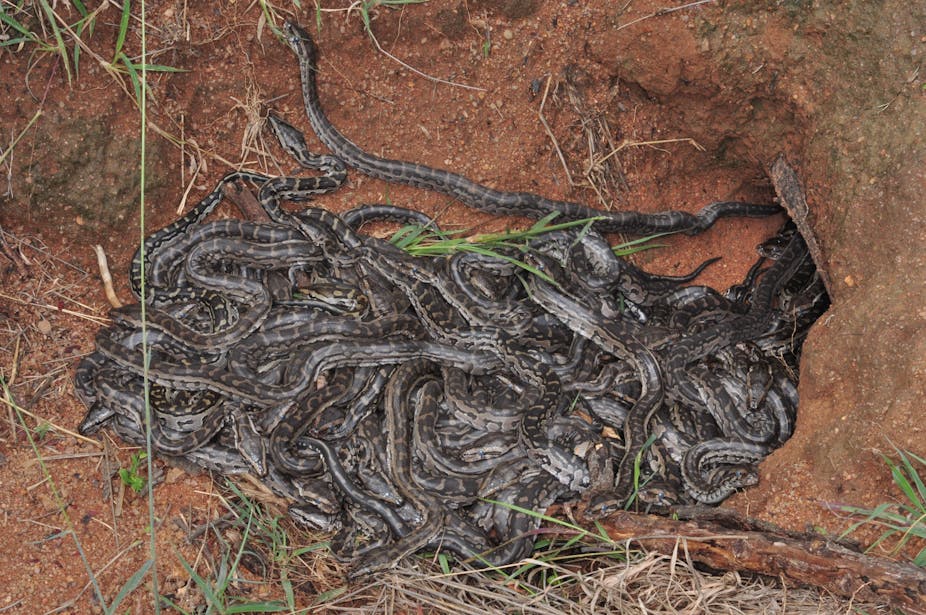Snakes are probably not the first creatures that spring to mind when you think about caring parents. But recent research has shown that several snake species are far more tender than their reputation suggests. We know now, for instance, that rattlesnakes den communally in winter while some species can recognise their kin.
I spent seven years studying wild pythons in the Dinokeng Game Reserve north of Pretoria, South Africa. Pythons were implanted with radio-transmitters and temperature recording dataloggers. When females laid eggs, I used surveillance video cameras installed in the underground nest chambers, usually in aardvark burrows, to record the behaviour of the breeding mothers and their babies in a natural setting.
I have made some important findings. For example, while it is well known that python mothers across all species incubate their eggs, we’ve now learned that southern African python mothers go one step further. They remain at the nest site with their newly-hatched young for two weeks or more. This discovery, which I recently published in the Journal of Zoology, marks the first known case of mothers in egg-laying snake species remaining with the clutch after the babies had hatched.
And I discovered that when southern African female pythons breed they change colour to almost black during the six month cycle. This process, known as facultative melanism, has not been reported in snakes before. It’s probably an adaptation that allows for faster rates of heating during basking, which is important for keeping the eggs and hatchlings warm.
This study highlights just how much there still is to discover about snakes. Even large, iconic snakes such as pythons still harbour many secrets. Unravelling the secrets matters because knowing more about the reproductive biology of snakes and lizards can reveal shed light on the evolution of parental care in birds and mammals.
Making babies and changing colour
Mating in southern African pythons is a serious business, and is rarely just a one-night stand. Some males were recorded remaining with receptive females for months. In one instance a male followed a female for more than 2 kilometres over a three month period. And when he went through a shedding cycle and got left behind, he found her again after she had moved a kilometre away.
The female’s dark breeding coloration, and the resulting heat retention, is important. Mothers of some types of python, such as Burmese python, are able to metabolically raise their body temperature, using the heat to incubate their eggs. This physiological response is termed facultative thermogenesis.
The southern African python and Burmese python are close relatives, but southern African pythons are not able to generate heat in this way. They rely solely on basking to raise their body temperature to almost 40 °C, then return to the nest cavity and coil around their eggs to warm them with their sun-derived body heat.
Body temperatures of receptive, pregnant and brooding female southern African pythons are more than 5 °C warmer than non-reproductive females. Even the body temperatures of baby-attending mothers are significantly higher than non-breeding females. These high temperatures are thought to improve egg development in the female, help with incubation and then help the babies to digest the last remaining egg yolk once they have hatched.
After southern African python babies hatch, they remain at the nest site with the mother. For the first day or so, they remain on the clutch of eggs, but they then regularly trek to the surface where they bask for short periods tightly packed together with their nest mates. At night, the babies rest protected and warmed in their mother’s coils in the nest chamber. The babies shed their skin 12 to 14 days after hatching. A few days later, they all disperse from the nest during the night.
A gruelling process
Reproduction takes a lot out of a female southern African python. Breeding females lose about 40% of their pre-laying body mass. In spite of this, they devote themselves to their clutch and don’t feed during their pregnancy, egg brooding and while they stay with their young – a period of more than six months.
By the time they leave the nest, the females start foraging for food, typically by lying in ambush along a game path. The most common prey for large female pythons are impala and grey duiker, but a wide range of prey can be on the menu.
They may take several years to recover their body condition. So, at best, wild female southern African pythons breed only every other year. Males, meanwhile, are sexually active every year.

